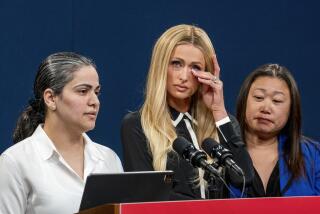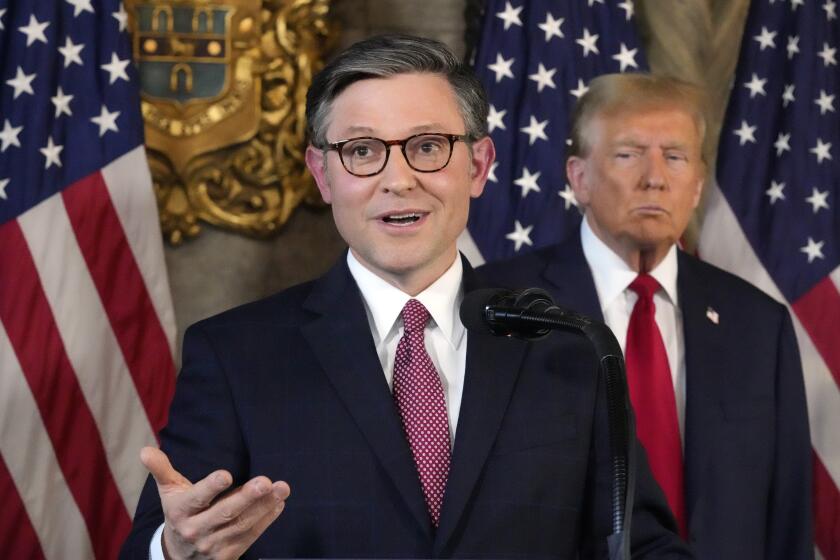Obama’s insular White House worries his allies
In the West Wing it had become a pretty common sight: two national security aides with close ties to the president, Thomas Donilon and Denis McDonough, hurrying into the Oval Office to show him the latest piece of hot intelligence.
Some administration officials who watched the scene unfold worried that James L. Jones, the national security advisor at the time, was being left out of the loop and that Obama was being given raw reports before their meaning and import were clear.
A strong national security advisor might weed out what the president doesn’t need to see. Yet Obama never quite clicked with Jones — and the absence of a personal connection with the commander in chief turned out to be a handicap.
In the fall, Jones abruptly resigned. Obama quickly replaced him with Donilon, a member of his 2008 transition team and a figure with a long history in Democratic politics. McDonough, a top foreign policy aide on Obama’s campaign team, was made Donilon’s No. 2.
Obama’s executive style relies heavily on a cordon of advisors who were with him at earlier points in his career. In nearly every instance, as senior advisors have resigned, Obama has filled the vacancies with trusted confidants who are closer to him than the people they replaced.
Gone is Christina Romer, a UC Berkeley professor who chaired his Council of Economic Advisors. In is Austan Goolsbee, a longtime Obama campaign aide who is confident enough about his relationship with the president that at a celebrity comic night last year he joked: “Look, I’m not saying that in 1961 we were, like, separated at birth — in a village in Kenya — what I’m saying is that we’re friends.”
Out is Rahm Emanuel, the ambitious chief of staff now running for mayor of Chicago; in is Pete Rouse, who was chief of staff in Obama’s Senate office and who helped chart Obama’s rise from freshman senator to president.
Atop the pyramid is a quartet of longtime friends and campaign aides: senior advisors Valerie Jarrett and David Axelrod, Press Secretary Robert Gibbs, and Rouse. Though Obama is likely to reshuffle staff next year and assign some people to different roles, none of the big four is expected to leave his orbit. Axelrod will leave the White House to begin planning for the reelection campaign, but his replacement is expected to be David Plouffe, who ran the 2008 Obama campaign.
For the foreseeable future Obama will be surrounded by a phalanx of aides utterly devoted to his political interests. That probably will focus the decision-making. But Democratic allies and even some White House officials are hoping he doesn’t lean too far in this direction, creating an insular presidency.
With Republicans in charge in the House next year, the Democrats contend, Obama needs new faces who might be better suited to negotiate with a resurgent GOP and come up with a fresh alternative to the now-dated 2008 campaign message of “hope and change.” Some names being tossed around: former Secretary of State Colin Powell; outgoing Pennsylvania Gov. Edward G. Rendell; and Erskine Bowles, a former chief of staff to Bill Clinton and co-chairman of Obama’s deficit reduction panel.
“He’s dealing with a new reality,” Douglas Schoen, a pollster who advised Clinton, said in an interview. “He desperately needs new people inside and outside of government to advise him and help frame a strategy to deal with an environment where Republicans have a new majority.”
In the Clinton era, the White House would call in governors, politicians and others to explain major undertakings like the 1996 welfare overhaul. When governors would come to town, Clinton’s staff would often invite them in to smoke a cigar with the president in the White House residence.
The White House “is a very isolating place,” said former Clinton aide Marcia Hale, “unless you really try to break out.”
“The thing that’s not there now that has been there in the past is base-touching and outreach contact,” said Peter Peyser, a Democratic lobbyist whose clients include cities and states. “What’s lacking is a taking of the pulse of people outside the circle.”
The White House says Obama likes to hear many voices and does not favor his inner team. Aides often point to Obama’s habit of going around the room at meetings and calling on comparatively junior-level staff members who hadn’t spoken out. The White House says that Jones was involved in all important meetings and that his views were accorded great value, adding that Donilon has ample foreign policy expertise and by virtue of his experience was able to make a seamless transition to the top security job.
In many ways, the White House structure is a reflection of the Obama temperament.
This is a president who doesn’t like surprises. He prefers familiar faces and rituals. He plays golf with a stable foursome that often includes Marvin Nicholson, his trip director and a former caddy; takes vacations with a close circle of friends from Chicago; stays in the same hotels on the road (in Des Moines, a modest Hampton Inn) as he did during his campaign.
Not just anyone gets close. In a 10-day getaway to Martha’s Vineyard this summer, the president stayed with his family at the same secluded farm they had rented the year before. On rainy days he played Scrabble with longtime Chicago friend and senior advisor Valerie Jarrett. He dined with Jarrett and two other Chicago friends, Eric and Cheryl Whitaker, at the Sweet Life Cafe, the same restaurant he had visited the previous year. Whitaker has rejoined Obama in Honolulu this week, golfing with him Thursday.
As the midterm election played out, Obama’s method of operation faced withering scrutiny. He lost his working majority in the House and seemed rattled by the dimensions of what he called a “shellacking.” In the last seven weeks, his team can point to a rebound: In the historic lame-duck session of Congress, Obama pushed through a nuclear arms treaty with Russia, averted a New Year’s tax increase and did away with the ban on gays serving openly in the military.
But his fundamental problem remains unsolved. The economy isn’t creating nearly enough jobs, leaving the unemployment rate stuck at nearly 10%. So long as that number stays high, political analysts and even loyal Democrats say Obama is at risk of being a one-term president.
At comparable crisis points, other presidents have taken a different path. Obama has spoken privately with Clinton about how to cope with the new Republican majority. But he doesn’t seem eager to reprise the Clinton model.
Like Obama, Clinton faced a disastrous midterm election 16 years ago that cost his party control of Congress. Clinton rebuilt his White House through major personnel and policy moves. He began listening to outside pollsters and political advisors such as Schoen, Schoen’s polling partner Mark Penn and Republican strategist Dick Morris.
Obama’s outreach is more ad hoc. From time to time he calls in former Secretary of State Powell for a consultation. And he recently invited in outside economists, including Nobel Prize winner Joseph Stiglitz, to sound them out about the economy.
One former administration official said that even if Obama were inclined to bring in new faces, that might not be enough. White House advisors need entree to the president — and for that, they need to get past the big four: Axelrod, Jarrett, Rouse and Gibbs.
Asked whether the president is most comfortable with those aides, one former administration official said: “That’s true. And to some extent they’re going to keep it that way.”
More to Read
Get the L.A. Times Politics newsletter
Deeply reported insights into legislation, politics and policy from Sacramento, Washington and beyond. In your inbox three times per week.
You may occasionally receive promotional content from the Los Angeles Times.






